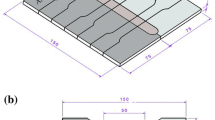Abstract
Since friction stir welding (FSW) does not create defects that are normally associated with fusion welds, it has become the preferred method for joining aluminum 7XXX series alloys. This work analyzes and compares friction stir welds of two different tempers in aluminum alloy 7449. A thorough analysis was done to characterize the two as-received alloys. Weld parameters were kept identical for the two different starting tempers. Thermocouples were used in the heat-affected zone at three different depths to obtain experimental thermal profiles. Hardness traverses and differential scanning calorimetry were used to analyze the strength of the welds and to analyze precipitate evolution. Simulated thermal profiles were generated via finite element analysis for the weld centerline. Our analysis confirms that preexisting precipitates in the as-received material have an effect on the final microstructure of the welds. A highly overaged aluminum 7449 alloy responds better to FSW as compared to a slightly overaged aluminum 7449 alloy.














Similar content being viewed by others
References
Kamp N, Sullivan A, Robson JD (2007) Modelling of friction stir welding of 7xxx aluminum alloys. Mater Sci Eng A 466(1):246–255
Kamp N, Sullivan A, Tomasi R, Robson JD (2006) Modelling of heterogeneous precipitate distribution evolution during friction stir welding process. Acta Mater 54(8):2003–2014
Mishra RS, Ma ZY (2005) Friction stir welding and processing. Mater Sci Eng R 50(1):1–78
Mishra RS, De PS, Kumar N (2014) Friction stir welding and processing: science and engineering. Springer, Berlin
Mishra RS, Mahoney MW (2007) Friction stir welding and processing. ASM International, Materials Park
Sullivan A, Robson JD (2008) Microstructural properties of friction stir welded and post-weld heat-treated 7449 aluminum alloy thick plate. Mater Sci Eng A 478(1):351–360
Su J, Nelson TW, Sterling CJ (2005) Microstructure evolution during FSW/FSP of high strength aluminum alloys. Mater Sci Eng A 405:277–286
Fuller CB, Mahoney MW, Calabrese M, Micona L (2010) Evolution of microstructure and mechanical properties in naturally aged 7050 and 7075 Al friction stir welds. Mater Sci Eng A 527(9):2233–2240
Dumont M, Steuwer A, Deschamps A, Peel M, Withers PJ (2006) Microstructure mapping in friction stir welds of 7449 aluminum alloy using SAXS. Acta Mater 54(18):4793–4801
Upadhyay P, Reynolds A (2014) Effect of backing plate thermal property on friction stir welding of 25-mm-thick AA6061. Metall Mater Trans A 45(4):2091–2100
Upadhyay P, Reynolds AP (2015) Thermal management in friction-stir welding of precipitation-hardened aluminum alloys. JOM 67(5):1022–1031
Rhodes CG, Mahoney MW, Bingel WH, Calabrese M (2003) Fine-grain evolution in friction-stir processed 7050 aluminum. Scr Mater 48(10):1451–1455
Martinez N, Kumar N, Mishra R, Doherty KJ (2017) Effect of tool dimensions and parameters on the microstructure of friction stir welded aluminum 7449 alloy of various thicknesses. Mater Sci Eng A 684:470–479
Martinez N, Kumar N, Mishra R, Doherty KJ (2017) Microstructural variation due to heat gradient of a thick friction stir welded aluminum 7449 alloy. J Alloys Compd 713:51–63
Li X, Starink M (2012) DSC study on phase transitions and their correlation with properties of overaged Al–Zn–Mg–Cu alloys. J Mater Eng Perform 21:977–984
Kamp N, Sinclair I, Starink MJ (2002) Toughness-strength relations in the overaged 7449 Al-based alloy. Metall Mater Trans A 33(4):1125
Piela K, Błaz L, Sierpinski Z, Forys T (2012) Non-isothermal annealing of AA7075 aluminum alloy—structural and mechanical effects. Arch Metall Mater 57(3):703–709
Farè S, Lecis N, Vedani M (2011) Aging behaviour of Al–Mg–Si alloys subjected to severe plastic deformation by ECAP and cold asymmetric rolling. J Metall 2011:1–8
Deschamps A, Livet F, Brechet Y (1998) Influence of predeformation on ageing in an Al–Zn–Mg alloy-I. Microstructure evolution and mechanical properties. Acta Mater 47:281–292
Yang W, Ji S, Wang M, Li Z (2014) Precipitation behaviour of Al–Zn–Mg–Cu alloy and diffraction analysis from η′ precipitates in four variants. J Alloys Compd 610:623–629
Nandan R et al (2007) Three-dimensional heat and material flow during friction stir welding of mild steel. Acta Mater 55(3):883–895
Song M, Kovacevic R (2003) Thermal modeling of friction stir welding in a moving coordinate system and its validation. Int J Mach Tools Manuf 43(6):605–615
Khandkar MZH, Khan JA, Reynolds AP (2003) Prediction of temperature distribution and thermal history during friction stir welding: input torque based model. Sci Technol Weld Join 8(3):165–174
Frigaard Ø, Grong Ø, Midling OT (2001) A process model for friction stir welding of age hardening aluminum alloys. Metall Mater Trans A 32(5):1189–1200
Chao YJ, Qi X, Tang W (2003) Heat transfer in friction stir welding—experimental and numerical studies. J Manuf Sci Eng Trans ASME 125(1):138–145
Shercliff HR, Colegrove PA (2002) Modelling of friction stir welding. In: Mathematical modelling of weld phenomena, vol 6. Maney Publishing, pp 927–974
Schmidt H, Hattel J, Wert J (2004) An analytical model for the heat generation in friction stir welding. Modell Simul Mater Sci Eng 12(1):143–157
Palanivel S, Arora A, Mishra R, Doherty KJ (2016) A framework for shear driven dissolution of thermally stable particles during friction stir welding and processing. Mater Sci Eng A 678:308–314
Author information
Authors and Affiliations
Corresponding author
Rights and permissions
About this article
Cite this article
Martinez, N., Kumar, N., Mishra, R.S. et al. Microstructural comparison of friction-stir-welded aluminum alloy 7449 starting from different tempers. J Mater Sci 53, 9273–9286 (2018). https://doi.org/10.1007/s10853-018-2201-z
Received:
Accepted:
Published:
Issue Date:
DOI: https://doi.org/10.1007/s10853-018-2201-z




